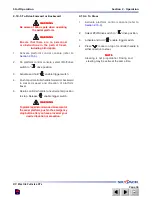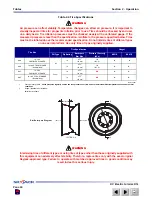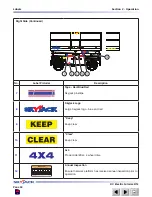
DC Electric Full-size RTs
December 2007
Page 51
TM
Section 2 - Operation
Battery Maintenance
2.16 Battery Maintenance
This section provides the operator with procedures
on how to service and charge the battery. This also
provides charger operation instructions.
2.16-1 Battery Service Procedures
wARNiNG
Explosion Hazard - Keep flames and
sparks away. Do not smoke near
batteries.
wARNiNG
Battery acid is extremely corrosive - Wear
proper eye and facial protection as well as
appropriate protective clothing. If contact
occurs, immediately flush with cold water
and seek medical attention.
1.
Ensure battery connectors are properly
connected.
2.
Check battery case for damage.
3.
Check battery fluid level in each battery. If plates
are not covered by at least 1/2 in. (13 mm) of
solution, add distilled or demineralized water.
4.
Clean battery terminals and cable ends thoroughly
with a terminal cleaning tool or wire brush.
5.
Make sure all battery connections are tight.
6.
Replace any battery that is damaged or incapable
of holding a lasting charge.
7.
Do not use any batteries other than flooded lead-
acid batteries of the proper AH rating.
wARNiNG
Use original or equivalent to the original
parts and components for the aerial
platform.
2.16-2 Battery Charging Operation
Figure 2-24. Battery Charger
DANGER
Risk of electric shock - Do not immerse
the charger in water. Though the charger
is highly resistant to water, it is not
designed for immersion and an electric
shock can occur.
1.
Provide adequate ventilation for the batteries and
charger. The convection cooled design requires
access to cooling air for proper operation. Do
not allow blankets or other materials to cover
the charger. Although the charger protects itself
against overheating, the charger cooling fins
should be cleaned if clogged with debris for best
performance.
wARNiNG
There could be a spark during charging.
Be careful when using fuels, solvents or
other flammables near the charger or
batteries.
2. Connect the power supply cord to a properly
grounded 100V/50 or 60Hz, 115V/50 or 60Hz, or
230V/50 or 60Hz socket. This charger automatically
senses and adjusts to the AC input voltage
range.
CAUTiON
When changing the input voltage wait
until all the LEDs are OFF or wait a
minimum of 20 seconds before switching
on the new voltage.

































